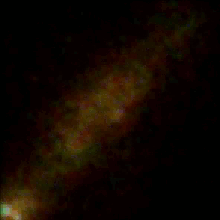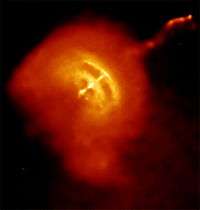Vela Pulsar
| Observation data Epoch J2000 Equinox J2000 | |
|---|---|
| Constellation | Vela |
| Right ascension | 08h 35m 20.65525s |
| Declination | −45° 10′ 35.1545″[1] |
| Apparent magnitude (V) | 23.6 |
| Astrometry | |
| Distance | 959+248 −163 ly (294+76 −50[2] pc) |
| Other designations | |
The Vela Pulsar (PSR J0835-4510 or PSR B0833-45) is a radio, optical, X-ray- and gamma-emitting pulsar associated with the Vela Supernova Remnant in the constellation of Vela.
Characteristics
It spins 11.195 times per second[3] (i.e. a period of 89.33 milliseconds—the shortest known at the time of its discovery) and the remnant from the supernova explosion is estimated to be travelling outwards at 1,200 km/s (750 mi/s).[4] It has the third-brightest optical component of all known pulsars (V = 23.6 mag)[5] which pulses twice for every single radio pulse. The Vela pulsar is the brightest persistent object in the high-energy gamma-ray sky.
Research campaigns
The association of the Vela pulsar with the Vela Supernova Remnant, made by astronomers at the University of Sydney in 1968,[6] was direct observational proof that supernovae form neutron stars.
Studies conducted by Kellogg et al. with the Uhuru spacecraft in 1970–71 showed the Vela pulsar and Vela X to be separate but spatially related objects. The term Vela X was used to describe the entirety of the supernova remnant.[7] Weiler and Panagia established in 1980 that Vela X was actually a pulsar wind nebula, contained within the fainter supernova remnant and driven by energy released by the pulsar.[8]
On 12 May 2015, a NASA research balloon was launched from Alice Springs in Australia's Northern Territory, taking aloft instruments developed as a joint project between Nagoya University and Kobe University in Japan to measure gamma ray output from the Vela Pulsar. The flight was expected to end near Longreach, Queensland, after sunset.[9]
What it is not
The pulsar is occasionally referred to as Vela X, but this phenomenon is separate from either the pulsar or the Vela X nebula. A radio survey of the Vela-Puppis region was made with the Mills Cross Telescope in 1956-57 and identified three strong radio sources: Vela X, Vela Y, and Vela Z. These sources are observationally close to the Puppis A supernova remnant, which is also a strong X-ray and radio source.[10]
Neither the pulsar nor either of the associated nebulae should be confused with Vela X-1, an observationally close but unrelated high-mass X-ray binary system.
In music
The emissions of Vela and the pulsar PSR B0329+54 were converted into audible sound by French composer Gérard Grisey and used in the piece Le noir de l'étoile (1989–90).[11][12][13]
Gallery
 Cycle of pulsed gamma rays from the Vela pulsar
Cycle of pulsed gamma rays from the Vela pulsar Position of the Vela Pulsar in the Milky Way
Position of the Vela Pulsar in the Milky Way Video of Vela's particle jet
Video of Vela's particle jet
References
- ↑ "Vela pulsar". SIMBAD. Retrieved 9 January 2013.
- ↑ Caraveo, P. A.; De Luca, A.; Mignani, R. P.; Bignami, G. F. (November 2001). "The Distance to the Vela Pulsar Gauged with Hubble Space Telescope Parallax Observations". Astrophys. J. 561 (2): 930–937. arXiv:astro-ph/0107282
 . Bibcode:2001ApJ...561..930C. doi:10.1086/323377.
. Bibcode:2001ApJ...561..930C. doi:10.1086/323377. - ↑ Manchester, R. N.; Hobbs, G. B.; Teoh, A.; Hobbs, M. (August 2005). "ATNF Pulsar Catalogue: J0835-4510". VizieR Online Data Catalog. Bibcode:2005yCat.7245....0M.
- ↑ Lyne, Andrew G.; Graham-Smith, Francis (1998). Pulsar Astronomy (2nd ed.). Cambridge University Press. ISBN 0-521-59413-8.
- ↑ Mignani, R. P.; Zharikov, R. P.; Caraveo, P. A. (October 2007). "The Optical Spectrum of the Vela Pulsar". Astronomy and Astrophysics. 473 (3): 891. arXiv:0707.2036
 . Bibcode:2007A&A...473..891M. doi:10.1051/0004-6361:20077774.
. Bibcode:2007A&A...473..891M. doi:10.1051/0004-6361:20077774. - ↑ Large, M. I.; Vaughan, A. E.; Mills, B. Y. (October 1968). "A Pulsar Supernova Association?". Nature. 20 (5165): 340–341. Bibcode:1968Natur.220..340L. doi:10.1038/220340a0.
- ↑ Kellogg, E.; Tananbaum, H.; Harnden, F. R., Jr.; Gursky, H.; Giacconi, R.; Grindlay, J. (August 1973). "The X-ray Structure of the Vela X Region Observed from Uhuru". The Astrophysical Journal. 183: 935–940. Bibcode:1973ApJ...183..935K. doi:10.1086/152279.
- ↑ Weiler, K. W.; Panagia, N. (October 1980). "Vela X and the Evolution of Plerions". Astronomy and Astrophysics. 90 (3): 269–282. Bibcode:1980A&A....90..269W.
- ↑ Jeffery, Mark; Sleath, Emma (12 May 2015). "Huge research balloon launched in Alice Springs to observe neutron star Vela Pulsar". ABC News. Australia. Retrieved 12 May 2015.
- ↑ Rishbeth, H. (December 1958). "Radio Emission from the Vela-Puppis Region". Australian Journal of Physics. 11 (4): 550–563. Bibcode:1958AuJPh..11..550R. doi:10.1071/PH580550.
- ↑ Del Re, Giuseppe (2000). The Cosmic Dance: Science Discovers the Mysterious Harmony of the Universe. Philadelphia: Templeton Foundation. pp. 24–25. ISBN 978-1-890151-25-6.
- ↑ Luminet, Jean-Pierre (2011). Illuminations: Cosmos et esthétique (in French). Paris: Odile Jacob. pp. 419–420. ISBN 978-2-7381-2562-0.
- ↑ "Gérard Grisey (1946-1998): Le Noir de l'Étoile (1989-1990)" (in French). IRCAM. Retrieved 12 January 2016.
External links
| Wikimedia Commons has media related to Vela Pulsar. |
Coordinates: ![]() 08h 35m 20.65525s, −45° 10′ 35.1545″
08h 35m 20.65525s, −45° 10′ 35.1545″
